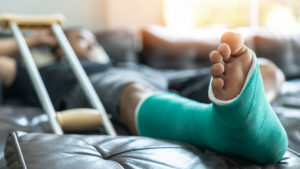Foot Injuries

Your feet support your body weight and constantly adjust to provide you with stability while you’re standing and walking. When you injure your feet, you could lose mobility, strength, and balance.
The feet have some of the most complicated structures in the human body. The feet include 26 bones held together with a network of over 100 muscles, tendons, and ligaments. The feet also have over 7,000 nerve endings. This means that even slight problems can cause constant pain.
Foot injuries can be serious. In this article, we’ll explore the circumstances that can surround injuries to the feet and the ways that you may be able to claim compensation for foot injuries.
How Do Foot Injuries Happen?
You can suffer a foot injury anytime you stress the bones, muscles, tendons, or ligaments of your foot. Some examples of ways in which foot injuries occur include:
Work-Related Injuries
The most common causes of foot injuries are work-related. If your job involves lifting, carrying, walking, or standing, you have a higher risk of foot injuries from workplace accidents.
Some of the common ways foot injuries happen at work include:
- Dropped objects
- Falling objects
- Missteps
- Trips
- Slips
- Falls
- Repetitive trauma
You may have trouble recovering from work-related foot injuries when doctors prescribe rest. If your job requires you to stand or walk, you might not get the rest you need, which can make the injury worse.
Sports Injuries
High-impact sports like running, tennis, and basketball can put a lot of stress on the feet. These sports also have a high risk of sprains due to missteps.
Sports injuries can occur due to defective products or hazardous conditions on someone else’s premises, too. For example, a manufacturing flaw in your shoes might cause a stress fracture. A pothole in a country club’s tennis court might result in a broken ankle.
Accidents
Foot injuries can happen in any type of accident that puts stress on your foot or ankle. Your foot could get crushed in a car accident. A slip and all accident in a grocery store might tear tendons and ligaments in your foot and ankle.
What Are the Different Types of Foot Injuries?
Damage to any of a foot’s structures could impinge on nerves and joints. As a result, you could experience searing pain with every step.
Some common types of foot injuries include:
Broken Bones

A heavy object falling or dropping onto the foot can break one or more of the foot bones. Similarly, crushing forces from a vehicle rolling over your foot or machinery trapping your foot can break bones in your foot.
Foot bones can also break from missteps. For example, stubbing your toe or tripping on an uneven surface can snap the small bones in the foot.
Falls can also break foot bones. Falling or jumping from a height of just a few feet can put enough stress on the bones to fracture them.
Traumatic forces are not the only causes of broken foot bones. Repetitive stress on your bones can lead to stress fractures. This type of injury can happen at work if you lift and carry heavy objects or do a lot of standing and walking.
The occupations at greatest risk of work-related foot injuries include:
- Construction
- Transportation
- Warehouse
- Retail
- Foodservice
- Fitness
These occupations also expose workers to other risks to their feet and ankles.
Tendonitis
Tendons attach your foot muscles to the foot bones. Tendonitis occurs when the tendons and the surrounding tissue become irritated and inflamed. Symptoms of tendonitis include pain and stiffness in the foot.
Tendonitis typically occurs due to repetitive stress and overuse. Doctors usually treat tendonitis by prescribing rest and non-steroidal anti-inflammatory drugs. But the foot tissue might require weeks or months of rest before the inflammation goes away. As a result, work-related tendonitis might persist because daily use prevents the tissue from healing.
Fasciitis
Muscles, tendons, ligaments, and nerves are surrounded by connective tissue called fascia. Repetitive use can cause the facia to become inflamed. This injury, known as fasciitis, can cause intense stabbing pain in the foot.
A common form of fasciitis is plantar fasciitis. The plantar fascia runs under the arch of your foot from your heel to your toes. Repeated walking, standing, and lifting can cause small tears in the plantar fascia. This can lead to plantar fasciitis.
Sprains and Strains
Ligaments hold bones to other bones. When you injure a ligament, you have a sprain. Tendons hold muscles to bones. When you injure a muscle or tendon, you have a strain.
Each of your feet has over 100 muscles, tendons, and ligaments. Strains and sprains can happen from traumatic force, repetitive stress, and missteps.
Strains and sprains are classified into three levels:
Minor or Grade I
In a mild or Grade I injury, the tears are small. They will typically heal on their own with rest. But you may experience some pain, swelling, and inflammation.
Moderate or Grade II
A moderate Grade II injury results from large tears in the tissue. Common symptoms include pain, bruising, swelling, and inflammation. With this type of injury, a doctor may immobilize your foot with a walking boot while your injury heals.
Severe or Grade III
In a severe or Grade III injury, the tissue becomes separated from the bone. A doctor will typically immobilize the injury with a cast. As a result, you may experience permanent structural instability afterward. You may even need regular physical therapy to build up the muscles around the injury to minimize re-injury risks.
What Compensation Can I Recover for Foot Injuries?
Traumatic foot injuries might lead to an insurance claim or a lawsuit. For example, you could file a claim for a foot injury caused by a slip and fall accident. This claim would be filed against the property insurance for the location in which you slipped. Similarly, you could include the damages from a foot crushed in a car accident in an auto insurance injury claim.
For on-the-job injuries, you will need to file a workers’ compensation claim. Workers’ comp can cover both traumatic injuries and repetitive stress injuries. This guarantees that workers are able to receive medical treatment and partial wage replacement while they recover from their work-related foot injuries.
Contact an Atlanta Personal Injury Lawyer at Hasner Law Injury & Workers’ Compensation Attorneys For Help
For more information, please contact the Atlanta personal injury law firm of Hasner Law Injury & Workers’ Compensation Attorneys at our nearest location to schedule a free consultation today at (678) 888-4878.


